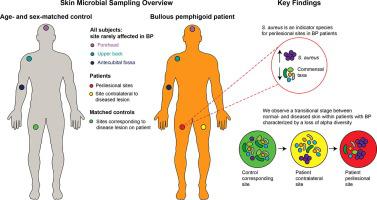Journal of Advanced Research ( IF 10.7 ) Pub Date : 2022-04-04 , DOI: 10.1016/j.jare.2022.03.019 Meriem Belheouane 1 , Britt M Hermes 2 , Nina Van Beek 3 , Sandrine Benoit 4 , Philippe Bernard 5 , Kossara Drenovska 6 , Sascha Gerdes 7 , Regine Gläser 7 , Matthias Goebeler 4 , Claudia Günther 8 , Anabelle von Georg 3 , Christoph M Hammers 9 , Maike M Holtsche 3 , Bernhard Homey 10 , Orsolya N Horváth 11 , Franziska Hübner 3 , Beke Linnemann 3 , Pascal Joly 12 , Dalma Márton 13 , Aikaterini Patsatsi 14 , Claudia Pföhler 15 , Miklós Sárdy 16 , Laura Huilaja 17 , Snejina Vassileva 6 , Detlef Zillikens 18 , Saleh Ibrahim 19 , Christian D Sadik 18 , Enno Schmidt 20 , John F Baines 2

|
Introduction
Bullous pemphigoid (BP) is the most common autoimmune blistering disease. It predominately afflicts the elderly and is significantly associated with increased mortality. The observation of age-dependent changes in the skin microbiota as well as its involvement in other inflammatory skin disorders suggests that skin microbiota may play a role in the emergence of BP blistering. We hypothesize that changes in microbial diversity associated with BP might occur before the emergence of disease lesions, and thus could represent an early indicator of blistering risk.
Objectives
The present study aims to investigate potential relationships between skin microbiota and BP and elaborate on important changes in microbial diversity associated with blistering in BP.
Methods
The study consisted of an extensive sampling effort of the skin microbiota in patients with BP and age- and sex-matched controls to analyze whether intra-individual, body site, and/or geographical variation correlate with changes in skin microbial composition in BP and/or blistering status.
Results
We find significant differences in the skin microbiota of patients with BP compared to that of controls, and moreover that disease status rather than skin biogeography (body site) governs skin microbiota composition in patients with BP. Our data reveal a discernible transition between normal skin and the skin surrounding BP lesions, which is characterized by a loss of protective microbiota and an increase in sequences matching Staphylococcus aureus, a known inflammation-promoting species. Notably, Staphylococcus aureus is ubiquitously associated with BP disease status, regardless of the presence of blisters.
Conclusion
The present study suggests Staphylococcus aureus may be a key taxon associated with BP disease status. Importantly, we however find contrasting patterns in the relative abundances of Staphylococcus hominis and Staphylococcus aureus reliably discriminate between patients with BP and matched controls. This may serve as valuable information for assessing blistering risk and treatment outcomes in a clinical setting.
中文翻译:

大疱性类天疱疮患者和对照组皮肤微生物群的特征揭示了新的疾病微生物指标
介绍
大疱性类天疱疮 (BP) 是最常见的自身免疫性水疱病。它主要折磨老年人并且与死亡率增加显着相关。对皮肤微生物群随年龄变化的观察及其与其他炎症性皮肤病的关系表明,皮肤微生物群可能在 BP 水疱的出现中发挥作用。我们假设与 BP 相关的微生物多样性的变化可能发生在疾病病变出现之前,因此可能代表水泡风险的早期指标。
目标
本研究旨在调查皮肤微生物群与 BP 之间的潜在关系,并阐述与 BP 起泡相关的微生物多样性的重要变化。
方法
该研究包括对 BP 患者的皮肤微生物群和年龄和性别匹配的对照进行广泛采样,以分析个体内部、身体部位和/或地理差异是否与 BP 和/或起泡状态。
结果
我们发现 BP 患者的皮肤微生物群与对照组相比存在显着差异,而且疾病状态而非皮肤生物地理学(身体部位)决定了 BP 患者的皮肤微生物群组成。我们的数据揭示了正常皮肤和 BP 病变周围皮肤之间明显的转变,其特征是保护性微生物群的丧失和与金黄色葡萄球菌相匹配的序列的增加,金黄色葡萄球菌是一种已知的炎症促进物种。值得注意的是,无论是否存在水泡,金黄色葡萄球菌普遍与 BP 疾病状态相关。
结论
本研究表明金黄色葡萄球菌可能是与 BP 疾病状态相关的关键分类群。然而,重要的是,我们发现人型葡萄球菌和金黄色葡萄球菌相对丰度的对比模式可靠地区分了 BP 患者和匹配的对照。这可以作为在临床环境中评估起泡风险和治疗结果的宝贵信息。



























 京公网安备 11010802027423号
京公网安备 11010802027423号